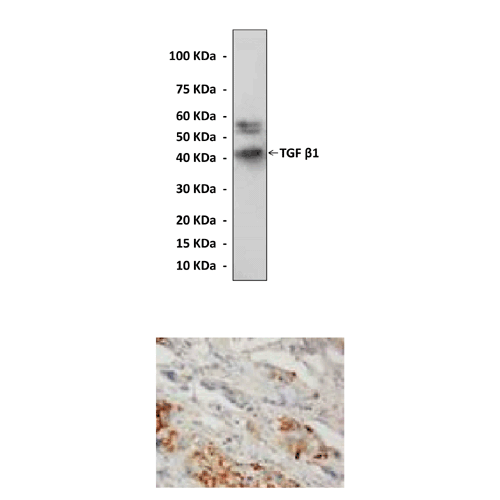BACKGROUND The TGF-beta superfamily of polypeptides comprises a group of highly conserved proteins, which includes various forms of TGF-beta, BMPs, Nodals, Activins, the anti-Müllerian hormone, and many other structurally related factors. They are ubiquitously expressed in eukaryotes and typically secreted into the extracellular milieu in an inactive form, where they become locally activated in response to the appropriate stimuli. These factors regulate cell migration, adhesion, multiplication, differentiation and death throughout the life span of the organism. The members of the TGF-beta family mediate such many different effects depending on the type and state of the cell. For example, in the same healing wound TGF-beta may stimulate or inhibit cell proliferation depending on whether the target is a fibroblast or a keratinocyte; in mammary epithelial cells TGF-beta will cause growth arrest or metastatic behavior depending on the level of oncogenic Ras activity present in the cell.1
Five TGF- beta have been cloned (TGF- beta 1–5). The structures of TGF- beta 1 and beta 2 have been solved. Eight of the nine cysteines make four intramolecular disulfide bonds, while the ninth cysteine (amino acid 77) forms an intermolecular disulfide bond with the corresponding ninth cysteine of the other monomer. The distinguishing feature of the TGF- beta structure is the ’cysteine knot, ’ formed from three of the four intramolecular disulfide bonds that maintains structural integrity for the monomer. TGF-beta signaling pathway is highly conserved from lower organisms to man. Although four receptors have been cloned (type I, II, III, endoglin), only two of them, the type II and type I receptors, have been conclusively proven to mediate TGF-beta signaling.2 TGF-beta binds to the type II TGF-beta receptor (TbetaR-II) kinase. The type I receptor (TbetaR-I) is then recruited into the ligand/TbetaR-II complex and phosphorylated and activated by the TbetaR-II kinase. The activated TbetaR-I receptor then phosphorylates receptor-associated Smad2 and Smad3, which, in turn, form complexes with the common Smad, Smad4, and accumulate in the nucleus. In the nucleus, activated Smad complexes, along with co-activators and cell-specific DNA-binding factors, regulate gene expression and ultimately cell cycle and tissue repair. It is important to realize that, besides this classical pathway, the TbetaR-II receptor is capable of partnering with other members of the type I receptor family, including Alk-1, Alk-2 and Alk-3. In these cases, TGF-beta signals can also activate the BMP Smads 1, 5 and 8. These alternate pathways normally appear to be restricted to certain cell- or tissue types, such as, e.g., endothelial, neuronal and epidermal cells, in which they activate distinct genetic programs. However, in the context of cancer, this second pathway can become constitutively activated and drive epithelial-to-mesenchymal transitions (EMT), cell motility and invasiveness, in which PI-3 kinase/Akt activation has been shown to be involved. It was shown that TGFbeta activates PI3K activity through association of TGFbeta RI and the p85 subunit of PI3K in its tumor promoter function. However, many studies indicate that TGF-beta signaling can act either as a tumor promoter or a tumor suppressor.3 TGFbeta elicits the tumor suppressor activity by potently inhibit the proliferation of epithelial, endothelial and haematopoietic cells. However, as tumors evolve, they often evade the TGFbeta growth inhibition due to mutational inactivation or dysregulated expression of various components of the TGFbeta signaling pathways or cell cycle regulatory network.4
REFERENCES
1. Massagué, J. : Annu Rev Biochem. 67:753-91, 1998
2. Hu, P. P. et al: Endocrine Rev. 19:349-63, 1998
3. Wang, J. et al: Cancer Res. 68:3152-60, 2008
4. Massagué, J. et al: Cell 103:295-309, 2000
Products are for research use only. They are not intended for human, animal, or diagnostic applications.
Cat.No.: | CA0290 |
Antigen: | N-terminal sequence of human TGFbeta |
Isotype: | Affinity-Purified Rabbit Polyclonal IgG |
Species & predicted species cross- reactivity ( ): | Human, Rabbit, Rat, Mouse |
Applications & Suggested starting dilutions:* | WB 1:500 to 1:1000 IP n/d
IHC (Paraffin) 1:50 to 1:200 ICC n/d FACS n/d |
Predicted Molecular Weight of protein: | 42 kDa |
Specificity/Sensitivity: | Reacts specifically with TGFbeta1 of human, rabbit, mouse & rat origin in Immunohistochemistry and immunoblotting procedures. No cross-reactivity was observed with TGFbeta2 or TGFbeta3. |
Storage: | Store at 4° C for frequent use; at -20° C for at least one year. |
*Optimal working dilutions must be determined by end user.









